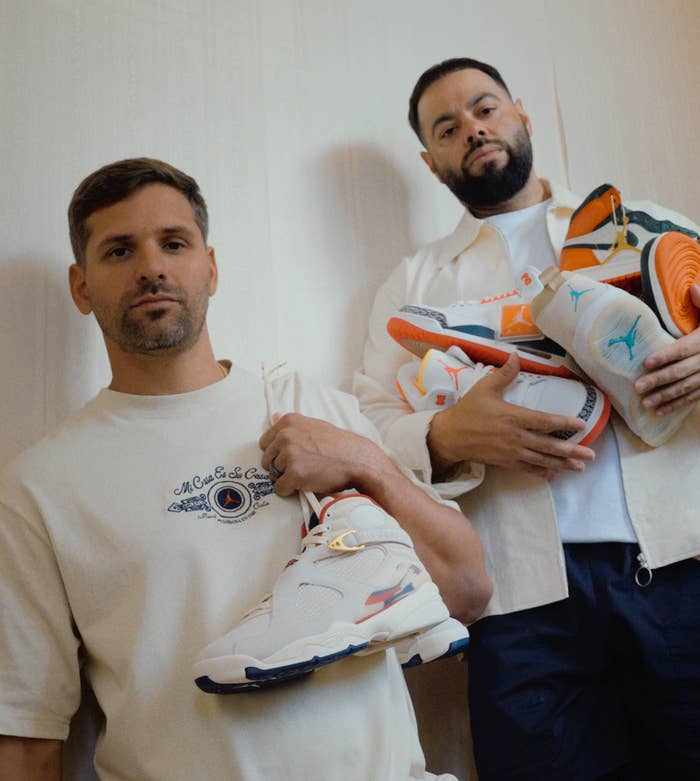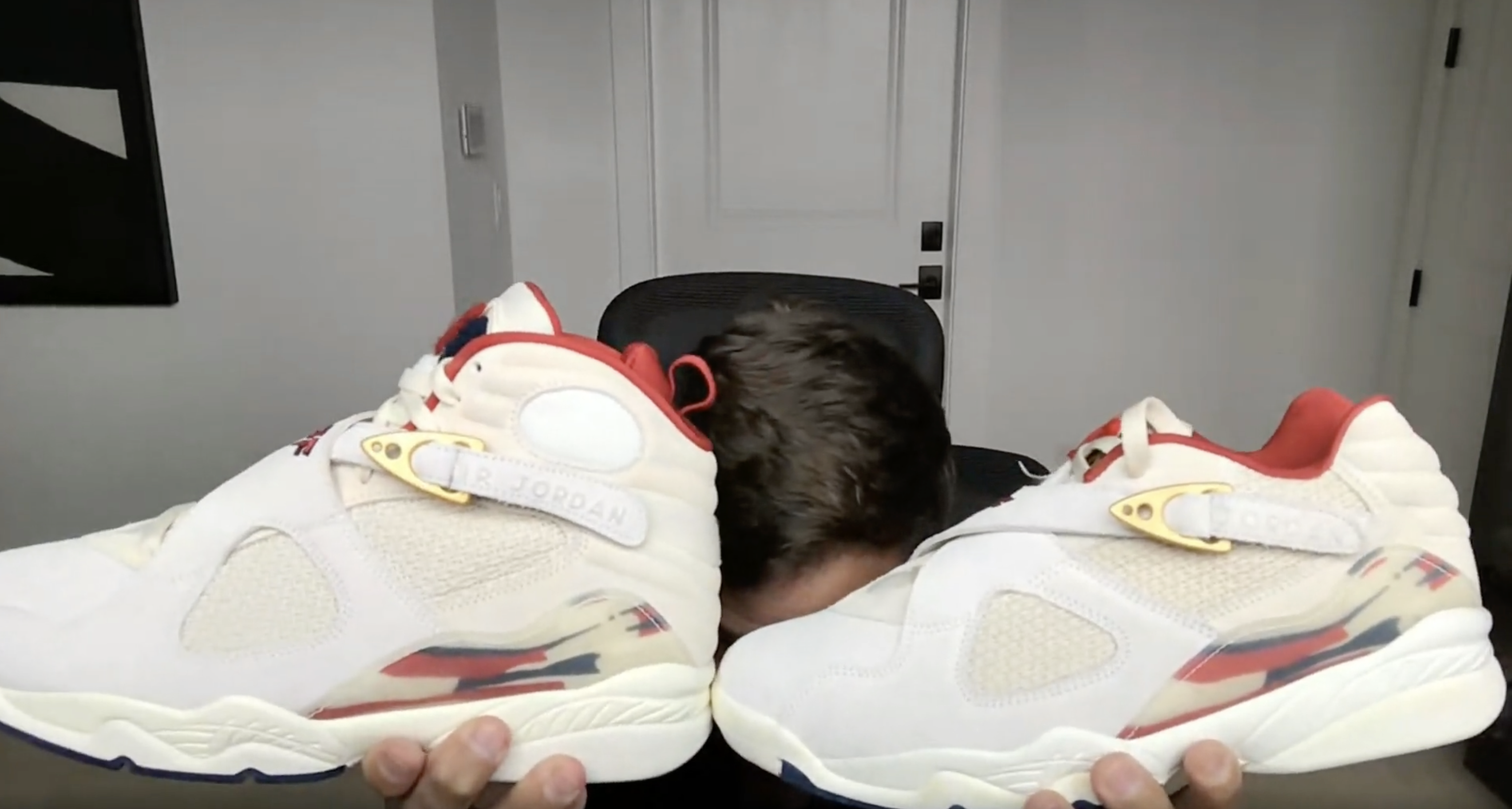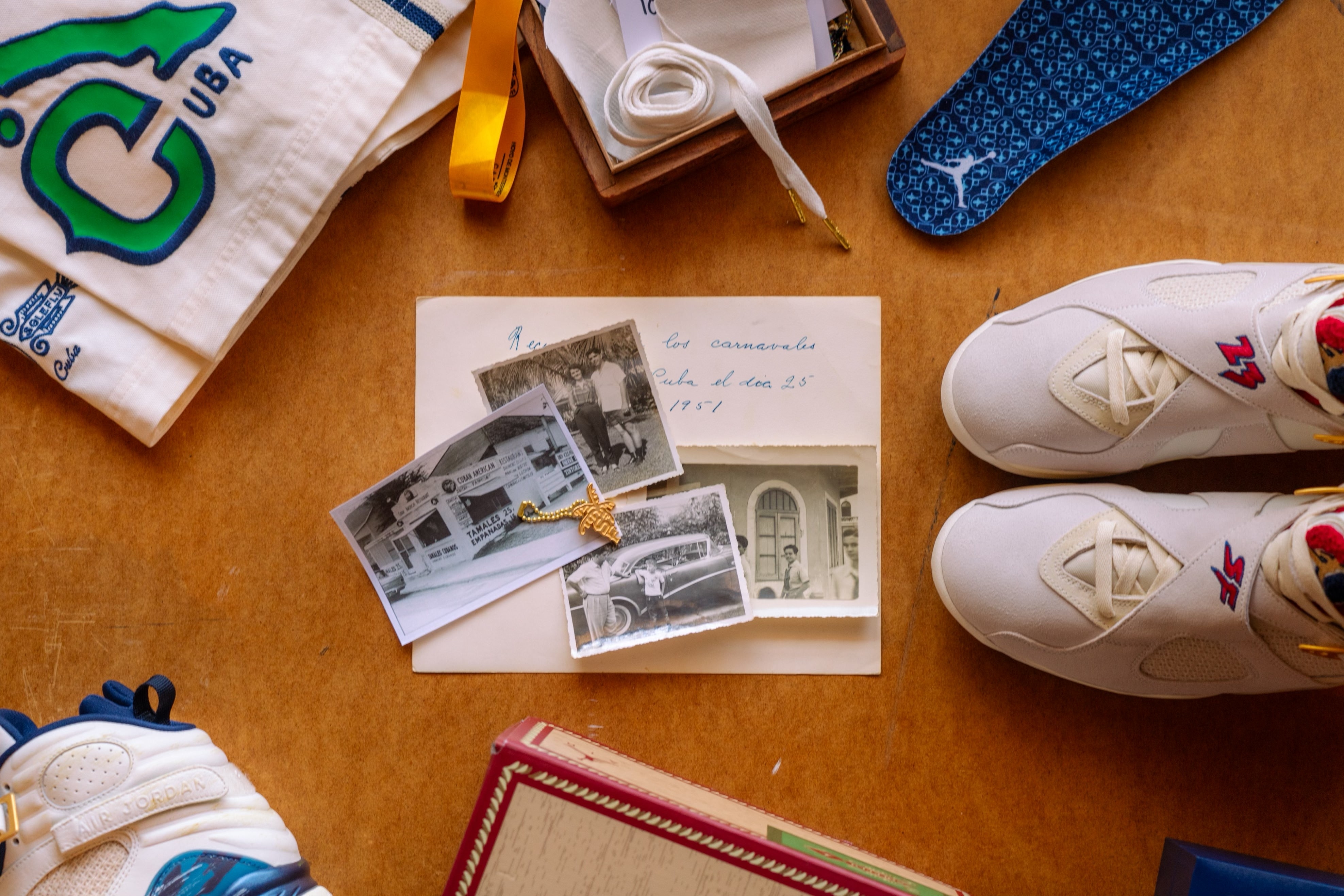
In 1993, months after completing his first three-peat with the Chicago Bulls and winning the NBA championship while wearing the Air Jordan 8, Michael Jordan hung up his sneakers in pursuit of another sport. It was the baseball diamond that beckoned him, and he would spend a little over a year playing in the minor leagues before eventually returning to the court. MJ’s stint in another sport was a blip in time, and isn’t often referenced on his Air Jordans, but longtime collaborator Solefly is combining the two worlds on its latest project.
Solefly, which is co-owned by Danny Hidalgo and Carlos Prieto, was founded in Miami in 2010. It’s since worked with Jordan Brand on over 20 pieces of footwear, the latest being an Air Jordan 8 that mixes Jordan’s connection to baseball with Miami culture and Hidalgo and Prieto’s Cuban heritage. The sneaker collaboration is premium—as always—and packed with details tying back to the inspirations. Even the rollout was considered, with the shoes first appearing on the feet of Miami Marlins players and first base coach Jon Jay, who’s a close friend of the Solefly family.
Prieto, who is Michael Jordan’s brother-in-law, says getting Jay and the Marlins laced in the shoes first was a priority.
“I reached out to Jay,” Prieto told Complex. “I said, ‘Hey, I need you guys to be one of the first to actually show the world a sneak peek of our shoe.’”
That first tease came on Sept. 20, just ahead of the Marlins' home bout against the New York Mets. Jay, Jazz Chisholm Jr., and Jorge Soler wore the shoes during pregame warm-ups. This was the first time the public saw the collab, but it wasn’t the first time it was teased. In July, Prieto previewed a sample Solefly x Air Jordan 8 with a navy upper and gold mesh underlays, one that was ultimately decided against due to its resemblance to the “Playoff” Jordan 8s releasing around the same window.
The sneaker’s connection to the Miami community will extend to its release, which takes place on Dec. 8 for a retail price of $225 during the city’s Calle Ocho festival. “The shoe being a Retro 8 releasing on the 8th releasing on Eighth Street, which is considered as one of the more historic streets in Miami,” Hidalgo says. “As far as for the Latinos, they have a big festival called the Calle Ocho, which is a big festival on Eighth Street. So there's a lot of play.”
Ahead of the launch, we caught up with Hidalgo, Prieto, and Solefly’s creative director of special projects Kevin Seage to find out more about the inspiration behind the project, how many stages of samples they had to go through before finalizing, and more. The interview has been lightly edited and condensed for clarity.

What can you tell me about the Jordan 8? I know it's got some inspiration from your Cuban roots—there are some ties to that. I know the wider Latin community in Miami was an inspiration.
Hidalgo: Yeah, like you said, the shoe definitely has a Cuban inspiration behind it. Since Carlos and I, our families are both from Cuba, we both have a Cuban background. So I would say that the shoe is heavily influenced by Cuba, from the Cuban tile design on the paper on the wrap inside the shoe box to the tile.
It's also on the insole of the shoe, which is inspired by an old Cuban tile that you would find in a lot of the houses in Cuba. To the mesh material that you will find on the windows on the side of the shoe, that was inspired by the couch that our grandmothers would have in Cuba. You know, Cuba is very well known for cigars. So we definitely had a very large cigar inspiration behind the shoes.
As you can see with the box, it looks like a cigar box. When you open up the box, the shoes are inside, but the physical box looks like an actual box of cigars. So there is a lot of Cuban heritage to the shoe from the cigars, the tile, the materials that we used, the suedes.
Also, the shoe also has a big baseball influence. Part of the reason that we made it kind of like a sail or off-white color was to give it that feel like it was being worn on a baseball field with the clay. So we took the colors from a Cuban baseball team, the Cuban Scorpions, which is an old baseball team out in Cuba, and they played their first major league game against the Baltimore Orioles in Cuba. So the shoe has a baseball background as well.
And so you mentioned some of the materials; you mentioned the mesh and the suede. It looks like there might be some other stuff going on there. How did you choose what you were going to use for that?
Seage: Yeah, the upper ankle window has a rugged canvas. The inspiration there was just kind of the immigrant journey that spans further than the Latino community. Just for any immigrant moving to a new place is gonna notice like, he's gonna have to persevere and kind of get scrappy, do what they can.
And then as [that] kind of progresses, you get towards the suedes and stuff, which is a hint more durable, but just becoming more like a fine material and finished. Which represents more so like the opportunity to create in a new land and the freedom that comes with that. And then lastly, that window Danny mentioned, one of the first things on our mood board was baseball, just because of the ties it has to the Latino community. And down here in Miami, that's kind of the first sport everybody's introduced to. Since the 8 also released around the time [Michael Jordan] was interested in baseball, we referenced that on the mesh. So our version of it ended up being this woven textile that Danny said represents a lot of textiles you'll find on Latino clothing and furniture, which is like a woven either cane weave or like a wide eyelet mesh.
And then gold hardware. Cuban link gold was something that we wanted to kind of throw in there a little, just a little like a more playful nod towards some of the more cultural.

Hidalgo: Then the main thing of the shoe is when you open up the straps, it has a very popular Hispanic saying, that you know, everybody uses “Mi casa, su casa.” Very Latin saying, you can use that in any Latin household, “Mi casa, su casa.” All the Latinos use it, whether it's Cuban, Mexican, Puerto Rican. It's just a very, very commonly used phrase in Hispanic culture.
Seage: Yeah, and as it relates to the whole collection, I think one of the concepts we spoke about early on with Jordan was kind of inviting the whole world to experience the Latin community down here, kind of those stories moving forward.
Hidalgo: Kind of welcome them into our world. I think Miami is almost 80 percent Hispanic. So when you come to Miami, you're always gonna have a huge Latino influence just because of the population demographics.
Prieto: We also added, I don't know if you noticed, but you see this 23 on the 8; we kind of mimicked it with the SF, the same font like that. You guys saw the inside part of the shoe is canvas.
So it flips from the outer to the inner. I see.
Prieto: You got the canvas here, and then it floats over to the other side. It's not too much of this mesh material. We didn't want an OD on it, but we just introduced it on the outer.
This one here is gonna be friends and family [holds up a low-top version]. We just took off the top.

The baseball connection is something I want to get into, how that partnership with the Marlins came about. How did you decide, this is how we want to announce it? This is how we want to roll it out. When you approached them, were they totally on board?
Prieto: Yeah. Our good friend is Jon Jay, first base coach of the Marlins. So I reached out to Jay. I said, “Hey, I need you guys to be one of the first to actually show the world a sneak peek of our shoe.” So I've known Jay since he was playing for UM back in 2010, and we're longtime friends and he made it happen for us. So we got the Marlins involved, and they were super hyped about that.
Yeah, I thought that was a cool way to introduce it. You don't see a lot of sneaker brands, or many stores, really taking that route with the rollout. It’s usually pretty straightforward.
Hidalgo: Yeah. So we had, you know, Jon Jay, kind of almost a childhood friend of ours, who also has a Cuban background. We had [Jorge] Soler, who is a World Series MVP from a couple of years ago. He’s also from Cuban descent. He introduced the shoes along with Jazz.
You showed me the tile on the insole, the “mi casa su sasa” on the inner straps. Are there any other hidden details going on there that you can maybe either tell me about or just hint at?
Prieto: Oh, we are doing some wooden boxes, custom wooden boxes, 23 of them. Only 23— they're gonna be numbered.
Seage: Yeah, so through the whole rollout of it, we're tapping local creators. In this case for the seeding kits, we are gonna do 23 wooden boxes that are made locally by Cuban father and son wood workers that are basically mimicking a cigar box. So it's a cedar cigar box, has a laser engraving on top like a cigar box to it, and then a little seal and gold class kind of like that authenticity seal that comes on a Cuban cigar box.
As far as the only other detail I think we haven't really gone over is the back heel tab. So on the [Jordan] 8, usually that is like super pronounced, super saturated and... So we basically faded it out and made it semi-opaque or transparent. That was like one of the first things that popped into our head when we saw the 8 and thought about it within Cuban culture. We blended those together and that, to us, represented immediately the stripes on the Cuban or American flag and kind of the blending of those two cultures within Miami.

I obviously want to focus on the new one, but that navy pair is cool, and I'm curious, how many sample rounds did you all go through? Like how many different pairs did you try out before you landed on the retail version?
Hidalgo: That's a good question. A lot. I would say, what were you thinking, Kevin? Like 15 different samples that we were seeing? Or more?
Seage: We probably did. No, let’s see, actual in-hand, I think we had about eight.
Hidalgo: Was it like [rounds of] three and four? And then we did three rounds, something like that?
Seage: Yeah, the first round is the two navy ones, and then they came back with I think, yeah, like five or six [different options], and then two [more]. So there were probably around 10 options. The navy pair was the most different in comparison with the rest of them. The rest of them all were toned down, more neutral colors. What was different was really just materials and executions.
Hidalgo: Yeah, we like the navy pair. We just thought it looked too close to the “Playoff” original that was coming out a month before the shoe.
Prieto: Not only that, this is so much more wearable. This paint, the paint strokes here [on the original navy sample] are like in your face; the [retail version] are like, not in your face. I wanted that in that shoe, not so in your face, you know?
Seage: Oh, yeah. I think just in general taking the 8 was kind of a challenge that we took on well. But I think one of the things we wanted it to be was to be something wearable that fits within like the modern styling. Like everybody wears a 1, 2, 3, let's say through 5. But once you get kind of up into the 8, it's a little tougher to wear. So that was a focus that we wanted to hit on, was making an 8 something that is wearable and fits into that like a normal sneaker rotation.

You mentioned the 8 being a little different from some of those models, [and you] went through 10 different samples. Would you say it was more challenging than some of your other projects with Jordan?
Hidalgo: Yeah, absolutely. Because there's just so many different components to the 8, you know, with the strap and the materials. It's just not—like a 1 is fairly simple. Even, you know, a 2 or 3. But the 8, it gets a little complex with the different patterns and the different materials and you have hardware on it. Straps, heel tabs, it's just a lot going on with that shoe.
Prieto: It has a lot of real estate.
Hidalgo: Yeah, a lot of real estate [laughs].
Solefly is in kind of a unique spot with its relationship with Michael Jordan. I'm just curious how much freedom and creative control do they give you all when it comes to a project like this? Like how much are you able to kind of just do your own thing or how much oversight do they have there?
Prieto: We just try to focus on, you know, one project a year type thing. We don't try to just do too much, too little. I think one a year is enough. You know, we used to do two or three and whatnot, but we're cutting it back. We wanna make our products as limited as possible. So once it hits out there it's pretty limited, you know; you don't see it too much.
Hidalgo: Definitely. Yeah. And I think your question was more on the actual, like, how much freedom do they give us on working on this type of project? Is that what you're trying to get at? For the most part, between the three of us, we pretty much designed the whole shoe top to bottom. There's a couple of things that they kind of give us, you know, a little pushback on. But for the most part from top to bottom, they're pretty lenient with, you know, going with what direction we wanna go in. We don't really get too much pushback on a lot of stuff unless it's a legal thing. Like, there's certain things that have to pass legal. But for the most part they're pretty lenient in giving us full access to, you know, using our inspiration on the shoe.

